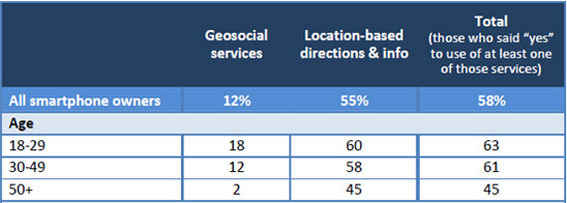According to a report released last week, 28 percent of American adults use some form of location-based service, either on a mobile device or via a social network.
The report from the Pew Internet & American Life Project — available here as a PDF — is the organization’s most extensive study of online location-related service usage to date.
In the report, Pew Internet Researchers Kathryn Zickuhr and Aaron Smith divide location-based services into three general categories. First, about 9 percent of American adult Internet users allow their social media posts or tweets to automatically include specific location information. This fact may interest ecommerce marketers, who, for example, may wish to include a similar location feature in blog comments or product reviews.
The report defined a second category of location-based services as geosocial applications like Foursquare or Gowalla, which are used by about 5 percent of adult Americans, according to Pew Internet. Multichannel merchants that sell online and via physical stores have, in many cases, been very effective in using these services to boost both real-world and digital traffic. For example, many locations of Radio Shack offer a 20 percent discount to shoppers who check in on Foursquare.
Pew Internet classified mobile phone-based driving direction or business recommendation services as its third category of location services, stating that some 28 percent of mobile phone owners — or about 23 percent of all American adults — use such services. This again may interest multichannel merchants.

Source: The Pew Research Center’s Internet & American Life Project, April 26 – May 22, 2011 Spring Tracking Survey. n=2,277 adults ages 18 and older, including 755 cell phone interviews. Interviews were conducted in English and Spanish.
“Taken together, 28 [percent] of U.S. adults do at least one of these activities either online or using their mobile phones—and many users do several of them,” wrote the Pew Internet researchers.
Demographic Differences
Pew Internet also reported some interesting demographic differences in terms of location-based service usage. These differences interest marketers seeking to reach particular shopper segments.
For example, the report states that Latino smartphone owners are far more likely to use geosocial services than are other ethnic groups. Specifically, a full 25 percent of Latino smartphone users check in using geosocial applications like the aforementioned Foursquare. By comparison, Pew Internet reported that some 7 percent of Caucasian smartphone owners use these services, while some 17 percent of African-American smartphone owners use geosocial services. This finding indicates that marketers using geosocial services may wish to tailor their offers to better serve Latino shoppers, as an example.

Pew Internet discovered ethnic differences in location-based service usage.
Age was also a factor in location-based service usage, according to the Pew Internet report.
Some 63 percent of American adults aged 18 to 29 use some form of location-based service. By comparison 45 percent of adult Americans 50 or older use these services or applications. About 18 percent of younger adults use geosocial services, while 12 percent and 2 percent of American adults 30 to 49 and 50 or older use these services respectively.

Pew Internet found a steep drop off in location-based service usage for Americans 50-year-old or older.
In general, American adults using smartphones were also more likely to engage location-based services than their “standard” mobile-phone-using counterparts. This is an important consideration since 35 percent of all American adults are smartphone users.
“In looking at broader uses of location-based services, we found that 55 [percent] of smartphone owners use their phone to get directions, recommendations, or other information related to their present location,” The Pew Internet researchers wrote. “This was the first time the Pew Internet Project has asked about general location-based services, which can range from GPS-enabled map services to reviews of nearby attractions using an app or a browser.”





